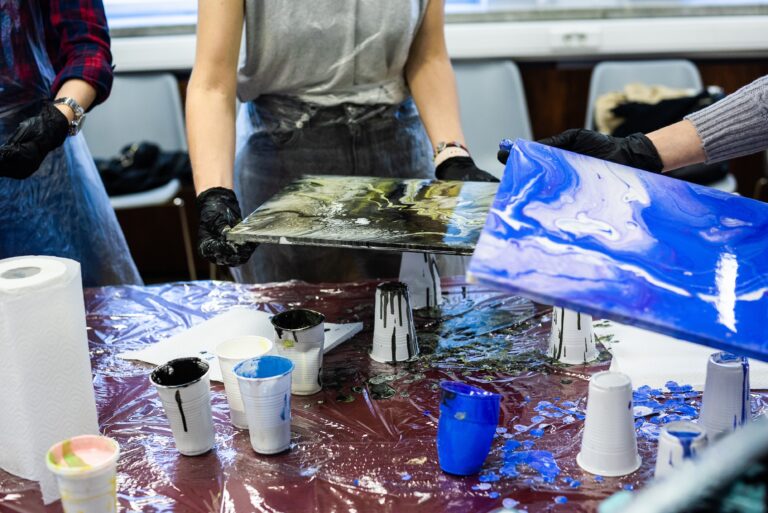
Art has the remarkable power to heal and transform.
Art therapy is a therapeutic approach that harnesses the creative process to improve mental, emotional, and even physical well-being. It has gained rapid recognition for its effectiveness in helping adults overcome challenges and traumas.
Main Line Counseling Partners is proud to have Teresa Thompson on our team, who has completed the highest level of art therapy training currently available. She has availablity and you can schedule a free consultation with her HERE.
Through the use of art forms, such as painting, drawing, sculpting, and collage, art therapy offers a unique avenue for adults to express and process their thoughts, feelings, and experiences in a safe and non-judgmental space.
This form of therapy can be particularly beneficial for those who find it difficult to articulate their emotions effectively.
Art therapy enables individuals to tap into their inner creativity, providing a means of self-expression that can alleviate stress, anxiety, and depression. It offers a transformative experience, allowing adults to gain insight into themselves, explore their identity, and find new perspectives on their personal journey.
Many adults don’t consider art therapy because they think it is only for kids.
In this article, we will delve into the power of art therapy for adults, exploring how this innovative approach can bring about healing, transformation, and self-discovery for all ages.
Understanding the Power of Art in Healing
Art therapy offers a wide range of benefits for adults. The creative process involved in art therapy can help individuals gain insight into themselves, explore their identity, and find new perspectives on their personal journey. Let’s take a closer look at some of the key benefits of art therapy for adults.
- Emotional Healing
Art therapy provides a safe and non-threatening space for adults to express and process their emotions. It’s not easy to talk about painful emotions. Art therapy offers an alternative form of communication, allowing individuals to express their feelings visually, through colors, shapes, and symbols.
The act of creating art can be cathartic, providing a release for pent-up emotions and allowing for emotional healing. Through art therapy, adults can explore and process difficult emotions such as grief, anger, or trauma, in a supportive and non-judgmental environment. This can lead to a greater sense of self-awareness and emotional well-being.
- Self-Expression and Self-Discovery
Art therapy provides a unique avenue for self-expression and self-discovery. Through the use of various art materials and techniques, adults can tap into their inner creativity and express themselves in ways that may not be possible through words alone. This can be particularly beneficial for those who feel disconnected from their emotions.
The process of art-making can reveal insights and uncover hidden aspects of the self, leading to self-discovery and personal growth.
- Trauma Recovery
Art therapy has proven to be an effective tool in trauma recovery. Traumatic experiences can leave lasting emotional scars, making it difficult for individuals to heal and move forward. Traditional verbal therapy may not always be enough to address the deep-rooted pain and trauma associated with such experiences.
Art therapy offers a unique approach to trauma recovery, allowing individuals to express and process their emotions in a safe and non-threatening way. The act of creating art can provide a sense of control and empowerment, allowing individuals to reclaim their narrative and rewrite their story. Art therapy can help individuals process their trauma, reduce symptoms of post-traumatic stress disorder (PTSD), and regain a sense of safety and trust.
- Stress Management and Relaxation
In today’s fast-paced and stressful world, finding healthy ways to cope with stress is essential for maintaining overall well-being. Art therapy can be a powerful tool for stress management and relaxation. Creativity brings a state of flow, where individuals are fully immersed in the present moment and completely absorbed in their art-making.
The rhythmic and repetitive motions involved in art-making can have a calming and meditative effect, similar to mindfulness practices. This can help reduce stress, lower blood pressure, and promote a sense of grounded relaxation. Art therapy can provide a much-needed respite from the demands of everyday life, offering a space for adults to recharge and rejuvenate.
- Mental Health Challenges
Art therapy has been widely recognized as an effective treatment for a range of mental health disorders. It can be used as a standalone therapy or as a complementary approach alongside traditional talk therapy or medication.
Art therapy has been found to be effective in the treatment of depression, anxiety, bipolar disorder, and eating disorders, among others. The creative process involved in art therapy can help individuals gain insight into their symptoms, develop coping strategies, and improve overall mental well-being. It can provide a sense of purpose, offering adults a way to navigate and make sense of their inner world.
The Benefits of Art Therapy for Adults
Art therapy encompasses a wide range of techniques and approaches, each tailored to the needs and goals of the individual. The specific art materials and techniques used in art therapy can vary depending on the therapist’s training and the client’s preferences. Let’s explore some of the common art therapy techniques used for self-expression and self-discovery.
- Painting
Painting is one of the most common art forms used in art therapy. It allows individuals to express themselves through color, texture, and brushstrokes. Painting can be a cathartic and expressive process, allowing individuals to release emotions onto the canvas.
Watercolor painting, acrylic painting, and oil painting are commonly used in art therapy sessions. Each medium offers unique qualities and characteristics that can be explored and experimented with. From bold and vibrant colors to soft and subtle hues, painting allows individuals to create visual representations of their inner world.
- Drawing
Drawing is another popular art form used in art therapy. It offers a versatile and accessible way for individuals to express themselves visually. Drawing can range from simple sketches to intricate and detailed illustrations, depending on the individual’s skill level and preferences.
Pencil drawing, charcoal drawing, and pastel drawing are commonly used in art therapy sessions. Each medium offers different levels of control and expressiveness. Drawing can be a meditative and relaxing process, allowing individuals to focus on the present moment and let their creativity flow.
- Sculpting
Sculpting involves shaping and manipulating various materials, such as clay or wire, to create three-dimensional forms. Sculpting can be a tactile and sensory experience, allowing individuals to engage their hands and senses in the creative process.
Clay sculpting, wire sculpting, and mixed media sculpture are commonly used in art therapy sessions. Sculpting can be a therapeutic process, allowing individuals to physically mold and shape their emotions and experiences. It can provide a sense of control and empowerment, as individuals create something tangible out of their inner world.
- Collage
Collage involves the arrangement and combination of various materials, such as magazine cuttings, photographs, and colored paper, to create a visual composition. Collage can be a versatile and expressive medium, allowing individuals to explore themes and concepts through the juxtaposition of different images and textures.
Collage-making can be a playful and creative process, allowing individuals to experiment with different materials and textures. It can be a visual representation of their thoughts, feelings, and experiences, creating a narrative that may be difficult to express through words alone.

I'm Ready to Start Creating Art
Are You in Pennsylvania?
If you or someone you know is interested in exploring the transformative potential of art therapy, finding a reputable art therapy program or therapist is crucial.
If you live in Pennsylvania we can help, and if you are near Philadelphia, PA, Ms. Thompson can see you in person.
If you do not live in Pennsylvania, research your local counseling centers or mental health clinics that offer art therapy for adults as part of their services.
Check out professional art therapy organizations, such as the American Art Therapy Association (AATA), which provide directories of registered art therapists. These directories can be accessed online and allow individuals to search for art therapists for adults in their area based on location and specialization.
Before committing to an art therapy program or therapist, it is advisable to schedule an initial consultation or interview. This meeting serves as an opportunity to discuss goals, expectations, and the therapeutic approach. It is crucial to feel comfortable and safe with the art therapist, as the therapeutic relationship plays a significant role in the effectiveness of art therapy.
Don’t be afraid to inquire about the therapist’s qualifications, experience, and credentials to ensure they are properly trained and licensed.
We wish you all the best in finding a qualified art therapist who sees adults in your area! 💕
